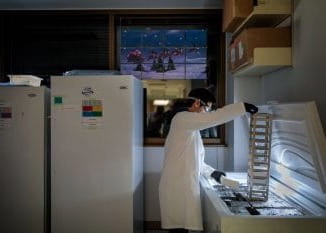ULT freezers use a significant amount of energy and are responsible for a considerable amount of greenhouse gas emissions. An average ULT freezer at WashU uses nearly as much electricity each year as an average US home.

WashU operates over 900 ULT freezers across all campuses. These use approximately 10,500,000 kilowatt-hours of energy each year, resulting in an estimated ~8,000 metric tons of greenhouse gas emissions, which is equivalent to the emissions from 1,850 cars.
Standard ULT freezers use refrigerants with a global warming potential (GWP) ranging from 1,000 to 12,400 times as potent as CO2. High efficiency (HE) ULT freezers can consume up to 50% less energy than non-HE models and utilize natural refrigerants that do not significantly contribute to global warming.
Reduce the need for ULT freezer capacity by cleaning out an existing unit or sharing with another lab. If a new freezer is needed, select an appropriately-sized HE ULT freezer to meet your needs.
- By switching to High Efficiency (HE) ULT freezers, Washington University can reduce its greenhouse gas emissions by ~2,000 metric tons per year.
- Some HE ULT freezers have the ability to operate in a standard mode or switch to an energy saving EcoMode which consumes an additional 15% less energy.
- Some HE ULTs have an integrated diagnostic system which continuously monitors the temperature of freezer components.
- Some samples can be safely stored at -70°C rather than -80°C. This can reduce energy use by up to 40%. Find out if your samples qualify at freezerchallenge.org
- Maximize space use in freezers and consider sharing with another lab to reduce the need for additional units.
- Maintain a detailed inventory of freezer contents to minimize the time the freezer door is open while you search for samples.
- Keep all seals free of ice build-up to ensure secure door closure.
- Follow regular preventative maintenance to ensure freezers are running as efficiently as possible. All freezers require regular preventative maintenance.
- ULTs more than 10 years old should be decommissioned as soon as possible and properly recycled by the EH&S Department. Do not repurpose within the lab or donate elsewhere. The net benefit of removing old ULT freezers from the grid outweighs disposal impacts.
- Consider replacing non-HE freezers between 5-10 years old because these units are nearing their end-of-life and are likely running inefficiently. Non-HE freezers less than 5 years old should be replaced with high-efficiency models as soon as funds become available.
The WashU purchasing policy mandates that all new ULT freezers meet minimum standards for energy efficiency and utilize natural refrigerants. Many brands and models satisfy these requirements through Energy Star certification. Contact Resource Management or email greenlabs@wustl.edu for a comparison of approved models.
Adding backup systems can ensure the safety of your samples in the event of a power outage. Notification systems can also give you peace of mind overnight and on weekends.
- A CO2 or liquid nitrogen back-up system can be installed on any freezer to provide approximately 8 hours of temperature stabilization if a compressor unit fails.
- Remote monitoring systems can immediately notify the PI and/or lab manager in the event of a unit failure.
- An HE freezer combined with these additional features has excellent reliability and has a lower price point than a dual-compressor unit.
The Freezer Challenge is an international campaign to reduce the energy demand of -80 freezers across the globe. Participants can earn points by completing preventative maintenance, defrosting, organizing samples, sharing or retiring old freezers, and more. Please visit freezerchallenge.org for full program information.
Check in later this year for details on the WashU Freezer Challenge beginning December 2020. By joining the freezer challenge, your lab could win prizes.